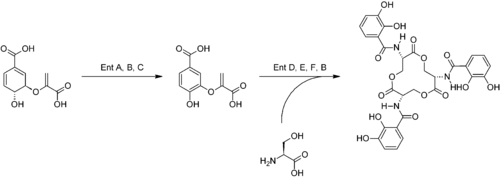Enterobactin
 | |
| Names | |
|---|---|
| IUPAC name
N,N',N''-((3S,7S,11S)-2,6,10- trioxo-1,5,9-trioxacyclododecane- 3,7,11-triyl)tris(2,3-dihydroxybenzamide) | |
| Identifiers | |
| 28384-96-5 | |
| 3D model (Jmol) | Interactive image Interactive image |
| ChEBI | CHEBI:28855 |
| ChEMBL | ChEMBL432995 |
| ChemSpider | 31543 |
| PubChem | 34231 |
| |
| |
| Properties | |
| C30H27N3O15 | |
| Molar mass | 669.55 g/mol |
| Except where otherwise noted, data are given for materials in their standard state (at 25 °C [77 °F], 100 kPa). | |
| | |
| Infobox references | |
Enterobactin (also known as Enterochelin) is a high affinity siderophore that acquires iron for microbial systems. It is primarily found in Gram-negative bacteria, such as Escherichia coli and Salmonella typhimurium.[1]
Enterobactin is the strongest siderophore known, binding to the ferric ion (Fe3+) with the affinity (K = 1052 M−1).[2] This value is substantially larger than even some synthetic metal chelators, such as EDTA (Kf,Fe3+ ~ 1025 M−1). [3] Due to its high affinity, enterobactin is capable of chelating even in environments where the concentration of ferric ion is held very low, such as within living organisms. Enterobactin can extract iron even from the air. Pathogenic bacteria can steal iron from other living organisms using this mechanism, even though the concentration of iron is kept extremely low due to the toxicity of free iron.
Structure and biosynthesis
Chorismic acid, an aromatic amino acid precursor, is converted to 2,3-dihydroxybenzoic acid (DHB) by a series of enzymes, EntA, EntB and EntC. An amide linkage of DHB to L-serine is then catalyzed by EntD, EntE, EntF and EntB. Three molecules of the DHB-Ser formed undergo intermolecular cyclization, yielding enterobactin. [5] Although a number of stereoisomers are possible due to the chirality of the serine residues, only the Δ-cis isomer is metabolically active.[3] The first three-dimensional structure of a metal enterobactin complex was determined as the vanadium(IV) complex.[4]

Mechanism
Iron deficiency in bacterial cells triggers secretion of enterobactin into the extracellular environment, causing formation of an coordination complex "FeEnt" wherein ferric ion is chelated to the conjugate base of enterobactin. In Escherichia coli, FepA in the bacterial outer membrane then allows entrance of FeEnt to the bacterial periplasm. FepB,C,D and G all participate in transport of the FeEnt through the inner membrane by means of an ATP-binding cassette transporter.[5]
Due to the extreme iron binding affinity of enterobactin, it is necessary to cleave FeEnt with ferrienterobactin esterase to remove the iron. This degradation yields three 2,3-dihydroxybenzoyl-L-serine units. Reduction of the iron (Fe3+ to Fe2+) occurs in conjunction with this cleavage, but no FeEnt bacterial reductase enzyme has been identified, and the mechanism for this process is still unclear.[6] The reduction potential for Fe3+/Fe2+–enterobactin complex is pH dependent and varies from −0.57 V (vs NHE) at pH 6 to −0.79 V at pH 7.4 to −0.99 at pH values higher than 10.4.[7]
History
Enterobactin was discovered by Gibson and Neilands groups in 1970.[8][9] These initial studies established the structure and its relationship to 2,3-dihydroxybenzoic acid.
References
- ↑ Dertz, Emily A., Jide Xu, Alain Stintzi, and Kenneth N. Raymond (2006). "Bacillibactin-Mediated Iron Transport in Bacillus Subtilis". J. Am. Chem. Soc. 128 (1): 22–23. doi:10.1021/ja055898c. PMID 16390102.
- ↑ Carrano, Carl J.; Kenneth N. Raymond (1979). "Ferric Ion Sequestering Agents. 2. Kinetics and Mechanism of Iron Removal From Transferrin by Enterobactin and Synthetic Tricatechols". J. Am. Chem. Soc. 101 (18): 5401–5404. doi:10.1021/ja00512a047.
- ↑ Walsh, Christopher T., Jun Liu, Frank Rusnak, and Masahiro Sakaitani (1990). "Molecular Studies on Enzymes in Chorismate Metabolism and the Enterobactin Biosynthetic Pathway". Chemical Reviews. 90 (7): 1105–1129. doi:10.1021/cr00105a003.
- ↑ Karpishin, Timothy B.; Raymond, Kenneth N. (1992). "The First Structural Characterization of A Metal-Enterobactin Complex: [V(enterobactin)]2-". Angewandte Chemie International Edition in English. 31 (4): 466–468. doi:10.1002/anie.199204661.
- ↑ Raymond, Kenneth N.; Emily A. Dertz & Sanggoo S. Kim (2003). "Enterobactin: An archetype for microbial iron transport". Proc. Natl. Acad. Sci. 100 (7): 3584–3588. doi:10.1073/pnas.0630018100. PMC 152965
 . PMID 12655062.
. PMID 12655062. - ↑ Ward, Thomas R.; Andreas Lutz; Serge P. Parel; Jurgen Eusling; Philipp Gutlich; Peter Buglyo & Chris Orvig (1999). "An Iron-Based Molecular Redox Switch as a Model for Iron Release From Enterobactin Via the Salicylate Binding Mode". Inorg. Chem. 38 (22): 5007–5017. doi:10.1021/ic990225e. PMID 11671244.
- ↑ Lee, Chi Woo; Ecker, David J.; Raymond, Kenneth N. (1985). "Coordination chemistry of microbial iron transport compounds. 34. The pH-dependent reduction of ferric enterobactin probed by electrochemical methods and its implications for microbial iron transport". J. Am. Chem. Soc. 107 (24): 6920–6923. doi:10.1021/ja00310a030.
- ↑ I. G. O'Brien; G. B. Cox; F. Gibson (1970). "Biologically active compounds containing 2,3-dihydroxybenzoic acid and serine formed by Escherichia coli". Biochim Biophys Acta. 201 (3): 453–60. doi:10.1016/0304-4165(70)90165-0. PMID 4908639.
- ↑ J.R. Pollack, J.B. Neilands, Enterobactin, an iron transport compound from Salmonella typhimurium, Biochemical and Biophysical Research Communications, Volume 38, Issue 5, 12 March 1970, Pages 989-992, doi:10.1016/0006-291X(70)90819-3.